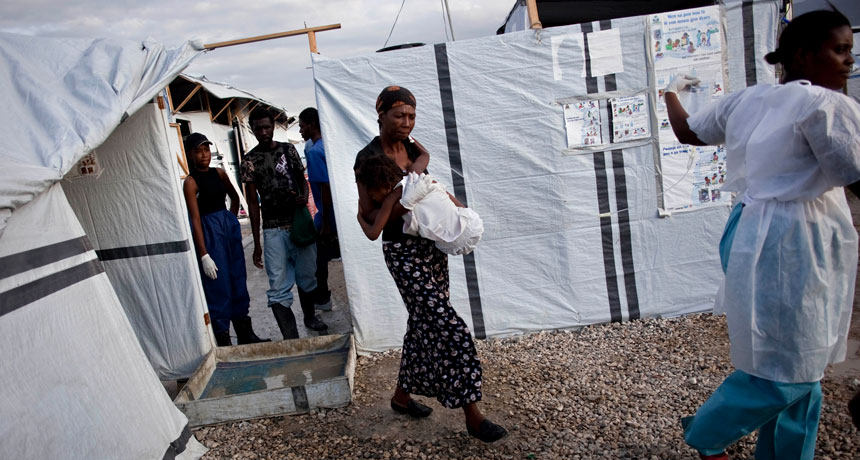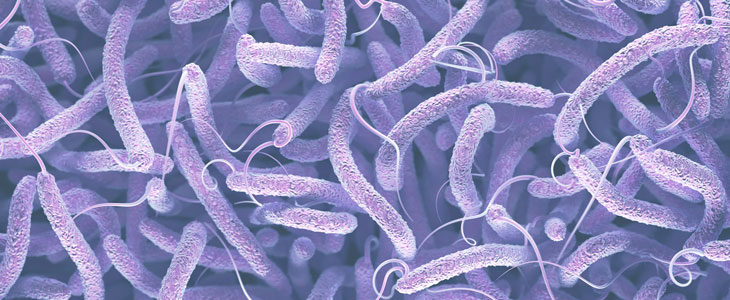Cholera pandemics are fueled by globe-trotting bacterial strains
Insight into how the bug spreads could help stop it

TREAT, STAT Rapid treatment to replenish fluids is crucial for cholera patients, like this young girl being taken to a health center in Haiti during the 2010 epidemic.
Guillermo Arias/Associated Press
- More than 2 years ago
Cholera strains behind worldwide outbreaks of the deadly disease over the last five decades are jet-setters rather than homebodies.
It had been proposed that these cholera epidemics were homegrown, driven by local strains of Vibrio cholerae living in aquatic ecosystems. But DNA fingerprints of the V. cholerae strains behind recent large outbreaks in Africa and Latin America were more closely related to South Asian strains than local ones, according to two papers published in the Nov. 10 Science.
This evidence that the guilty strains traveled from abroad could guide public health efforts, the researchers say. “If you don’t understand how the bug spreads, then it’s very difficult to try to stop the bug,” says François-Xavier Weill, a clinical microbiologist at the Institut Pasteur in Paris who coauthored both papers.
People are exposed to V. cholerae by consuming water or food contaminated by the bacteria. Poor sanitation and drinking water treatment can fuel an epidemic, as seen in Yemen (SN: 8/19/17, p. 4), where nearly a million people are suspected to have been infected and more than 2,000 have died in the world’s largest recorded cholera outbreak.
A cholera infection can produce mild or no symptoms. But about one in 10 people will rapidly develop severe diarrhea and dehydration that, without treatment, can kill within hours. Although underreported, cholera cases worldwide each year are estimated to range from 1.4 million to four million, and 21,000 to 143,000 people die from the disease, according to the World Health Organization’s Global Health Observatory.
Story continues below image

There have been seven cholera pandemics, or global outbreaks, since the 19th century, when the bacteria spread from its original home on the Indian subcontinent. The seventh one, which began in Indonesia in 1961, reached Africa in 1970 and hit Latin America in 1991, is still ongoing. It’s attributed to strains that originated near the Bay of Bengal, where cholera is a seasonal occurrence.
But it was unclear whether the large outbreaks happening around the world were related to each other, or if they had each originated from local strains. Previous methods used to track V. cholerae were unable to distinguish strains with enough detail, Weill says. “It was impossible then, during the last 50 years, to understand the routes of propagation of cholera.”
Weill and an international research team analyzed the genetic information of about 1,700 strains of V. cholera, including those collected during and in between outbreaks over about 40 years from 45 countries in Africa and 14 countries throughout Latin America.
In both Africa and Latin America, the strains responsible for the large epidemics were most closely related to the South Asian strains, rather than strains existing in the local environment. These “epidemic” strains have been introduced 11 times in Africa since 1970 and have caused large outbreaks that lasted as long as 28 years, the researchers found.
In Latin America, there were three main introductions of the South Asian “epidemic” strains. One that came through Africa hit Peru in 1991. Another invaded Mexico around the same time, possibly arriving with coca smugglers using an airstrip near Mexico City. The third introduction, from Nepalese United Nations personnel, devastated Haiti in 2010 (SN: 2/25/12, p. 16).
“We now know what cholera is with much more precision,” says Nicholas Thomson, a genome scientist at the Wellcome Trust Sanger Institute in Cambridge, England, who also coauthored both papers. “You can find V. cholerae in the environment, no doubt about it, but the patterns of spread tell you that that’s not the primary route of transmission.” Rather, he says, it’s transmission between people that allows the bacteria to spread rapidly internationally.
“These studies affirm the primary role that people play in the spread of cholera,” says Yonatan Grad, an infectious diseases clinician at Harvard T.H. Chan School of Public Health in Boston who was not involved with the studies. “The emphasis on infected people as the vectors for spread underscores the importance of vaccination as a strategy to limit cholera.”







